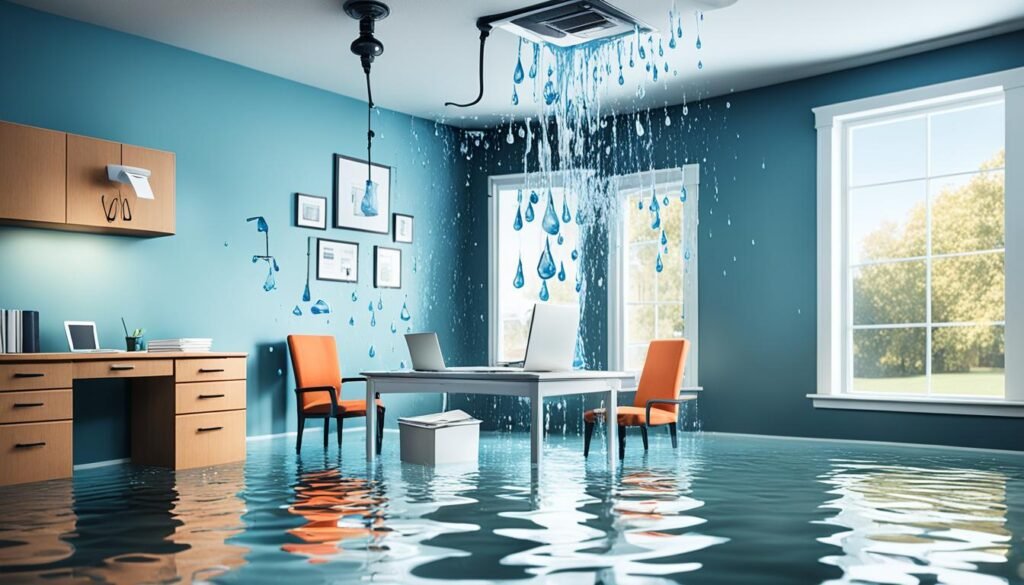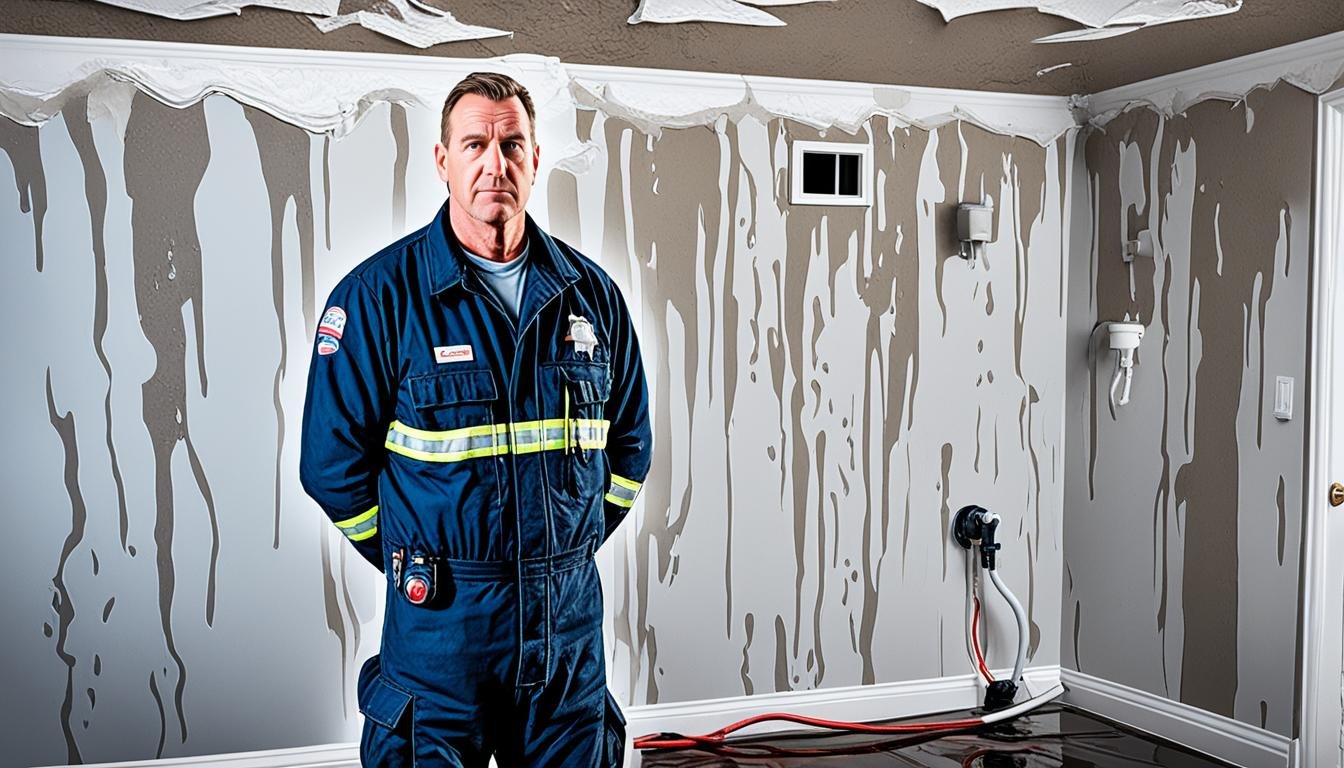Dealing with water damage in your home can be stressful, but grasping the basics of your insurance for water damage can significantly ease the financial burden. In most cases, a standard homeowners insurance policy is designed to protect you from the sudden and accidental havoc wreaked by water. From a burst pipe drenching your living room to an ill-timed water heater malfunction, understanding your policy’s response to these crises is essential.
As you navigate through the claims process, it’s vital to know the extent of your water damage insurance coverage. Your dwelling coverage will often shoulder the cost of repairing structural damage, whereas personal property coverage tends to handle the loss of your possessions. Nonetheless, it’s important to remember that your coverage has its limits and deductibles, which play a critical role in shaping the outcome of your claim.
Yet, not all water-related mishaps fall under the safety net provided by your policy. Routine wear and tear, or the gradual damage that occurs from a leaky toilet, may not be covered. Moreover, standard policies do not typically cover flooding — a separate policy through the National Flood Insurance Program may be necessary.
Committing to regular home maintenance and seeking clarity from your insurance provider are key steps in shielding yourself against the unforeseen expenses that can arise from water damage.
Key Takeaways
- Most homeowners insurance policies cover sudden and accidental water damage.
- Differentiate between dwelling and personal property coverage within your policy.
- Deductibles and coverage limits are critical factors in the compensation you receive.
- Maintenance-related issues and floods are often not included in standard policies.
- Engaging with your insurance representative can prevent future financial surprises.
Insurance Claims for Water Damage in San Bernardino: What Homeowners Need to Know
When it comes to water damage insurance claims in San Bernardino, the processes and policies may seem daunting. As a homeowner in this region, it’s crucial to understand that insurance coverage is typically provided for water damage that is sudden and accidental. However, the intricacy lies in the various reasons your claim could be challenged or even denied. Shifts in weather patterns and the unforeseen nature of water incidents necessitate being prepared for potential water-related losses in your home.
Water damage insurance claim tips often highlight the need for diligence—be on alert for signs of gradual damage, such as leaks that have gone unnoticed over time, and address them promptly. Mold issues, which can be a consequence of lingering moisture, might not be covered unless they are the direct result of a covered event. It’s also common for insurers to scrutinize claims to ascertain whether the damage occurred before the policy was in effect, which could lead to denials.
Sifting through a typical homeowners’ policy, you will find that settlements for insurance claims for water damage in San Bernardino vary. For example, an HO-3 policy generally provides replacement cost coverage for the structure of your home but may offer actual cash value for personal belongings – unless you have opted for added replacement cost coverage. Recognizing the differences in settlement options will aid in making informed decisions should you need to file a claim.

Moreover, understanding the specifics of your policy is imperative. Here are some useful measures to consider:
- Regularly review your policy to ensure it reflects your current needs and the risks specific to San Bernardino.
- Document proof of damage and maintenance efforts as insurers will likely require evidence if you file a claim.
- Seek professional assessments for complex scenarios such as water damage due to natural disasters or issues with the public sewage system.
By educating yourself on these nuances, you significantly enhance your ability to traverse the often complex terrain of water damage claims and secure just compensation for your losses.
When dealing with the repercussions of water damage in your home, it is paramount to understand the specifics of your insurance coverage. Water damage insurance claims often hinge on the nuances of your policy’s terms and the nature of the damage itself. Here, we’ll delve into the critical aspects of dwelling and personal property coverage, key exclusions to watch out for, as well as additional options like sewer backup and flood insurance that could be crucial in a comprehensive water damage recovery strategy.
Dwelling Coverage vs. Personal Property Coverage
The backbone of a standard homeowners insurance policy, dwelling coverage, addresses the repair or reconstruction costs of the physical structure of your home—anything from floors to ceilings to built-in appliances. On the flip side, personal property coverage targets your belongings, extending from clothes to gadgets impacted by water. Recognizing the differentiation between these coverages is essential when you embark on the water damage claim process, ensuring you discern precisely which damages your policy addresses.
Understanding the Fine Print: Exclusions and Conditions
An in-depth understanding of your policy’s fine print could significantly influence insurance claims for water damage. Common water damage exclusions include scenarios such as damage due to ongoing maintenance issues, water seepage entering from the ground, or damage from neglected leaks leading to mold. Moreover, the distinction between water damage and flood damage is fundamental, as the latter typically isn’t covered by a standard policy and requires separate flood insurance.
Additional Coverage Options: Sewer Backup and Flood Insurance
Expanding your insurance umbrella to include options like sewer backup coverage can provide financial relief from damages caused by sewer line issues—protection not usually found in basic policies. Additionally, residents might consider the National Flood Insurance Program (NFIP), which offers coverage tailored for flood-prone areas, thereby filling the coverage void left by conventional policies.
| Coverage Type | What It Covers | Typical Exclusions | Optional Add-ons |
|---|---|---|---|
| Dwelling Coverage | Structure of your home | Flood damage, Earth movement | Flood insurance |
| Personal Property Coverage | Your belongings within the home | Wear and tear, Neglect | Sewer Backup coverage |
By scrutinizing the extent of your dwelling and personal property coverage, recognizing commonly excluded scenarios, and exploring further safeguards like sewer backup and flood insurance, you’ll heighten the chances of a successful water damage insurance claim. Doing so not only boosts your knowledge but also fortifies your financial security against the unpredictable nature of water-related mishaps.
Conclusion
The journey to successfully filing an insurance claim for water damage may seem daunting, but with the right knowledge and actions, it can become manageable. In San Bernardino, being proactive is key in the face of potential water damage to your property. By understanding what your water damage insurance coverage protects against, and distinguishing between the protections for unexpected catastrophes and long-term property maintenance issues, you allow yourself the foresight to prevent and address water-related incidents swiftly. Knowing the water damage claim process, from initial damage assessment to the final settlement, is not only reassuring but can significantly expedite your recovery time after an incident.
Remember, when confronted with water damage, your immediacy can make all the difference. Document everything meticulously, take quick steps to prevent further damage, and review your policy details thoroughly. This level of diligence ensures that you’re well-prepared to file a comprehensive claim. And if you find yourself navigating complex waters or face uncertainties regarding the filing procedures, you have a supportive ally in Water Damage Pros. Available at 951-903-5429, this local resource offers personalized guidance to aid you through any intricacies of your insurance claim for water damage in San Bernardino.
Filing a claim need not be a solitary endeavor. Partner with the expertise that can shepherd you through the critical period following water damage, ensuring you’re equipped to recover and restore your sanctuary to its pre-damage condition. Armed with the correct information and the right team on your side, you can tackle the aftermath of water damage with confidence and tranquility.
FAQ
What types of water damage are covered under standard homeowners insurance policies?
Most homeowners insurance policies cover water damage that is sudden and accidental, like from a burst water heater or ruptured pipe. It generally includes dwelling coverage for the physical structure of your home and personal property coverage for your belongings.
Are there common reasons why water damage insurance claims are denied?
Claims may be denied if the damage is due to gradual deterioration, lack of maintenance, or if it’s determined that the incident occurred before the policy was in effect. Issues like mold and damage from a sewer backup are typically not covered by standard policies.
What is the difference between dwelling coverage and personal property coverage?
Dwelling coverage pays for repairs to the physical structure of your home, such as walls and roofs, while personal property coverage pertains to the homeowner’s belongings within the home, like electronics and furniture, that are damaged by a covered peril.
Standard policies often exclude water damage from floods, water that seeps through the foundation, and water backup from an outside sewer or drain. You may need separate flood insurance or additional endorsements for these scenarios.
Why is it important to understand the exclusions and conditions of my water damage insurance policy?
Knowing the details of your policy’s exclusions and conditions helps you understand what is and isn’t covered, which impacts how you would handle maintenance and whether you need additional insurance for comprehensive coverage against water-related incidents.
How can I enhance my insurance coverage for water damage not included in my standard policy?
You can purchase supplemental coverage options such as flood insurance through the National Flood Insurance Program or sewer backup coverage to protect against specific scenarios excluded from your standard homeowners policy.
What steps should I take to file a water damage insurance claim successfully?
Immediately document the damage, take steps to mitigate further harm, and notify your insurance provider. Detailed records, photographs, and a thorough understanding of your policy’s coverage details are crucial to successfully filing a claim.
Does homeowners insurance cover water damage caused by poor maintenance?
Generally, homeowners insurance does not cover damage resulting from poor maintenance. It is your responsibility to maintain your property and prevent issues such as mold or leaks that can lead to such damage.
What should I do if I’m not sure about my water damage insurance coverage?
Consult with your insurance provider or agent to clarify your coverage details, limits, and any potential gaps. They can provide personalized advice and help you understand your policy better.
Can Water Damage Pros in San Bernardino assist with my water damage insurance claim?
Yes, Water Damage Pros can offer guidance and support in dealing with your water damage insurance claim. They have expertise in documenting damage, understanding policy language, and can help streamline the claim process.


